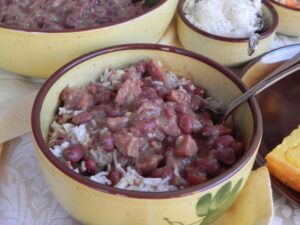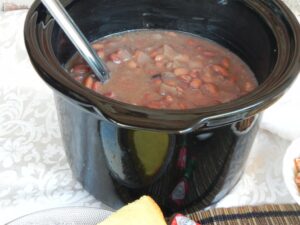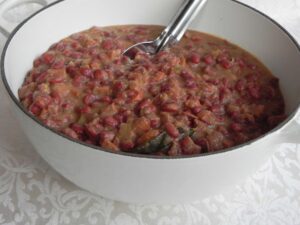Eating Oxford
On Cooking Southern: Beans and Cornbread
By Laurie Triplette
ldtriplette@aol.com
SOUTHERNISM OF THE WEEK
Colder’n a well-digger’s butt: So cold that a person feels cold from the inside out… the way we’ve all been feeling for the past few weeks, as Alberta Clippers and Arctic Blasts and Polar Express winds have blown across the nation. BBBBRRRRRRRRR.
POTS OF BEANS TO KEEP US WARM AND NOURISHED
Baby, it’s cold outside. As I write, the temperature is Oxford is 9˚F, which is downright balmy compared to the 5˚F temperature we achieved a week ago. Who knew Oxford would be colder this week than Park City and the Sundance Festival?
We’ve been fortunate, compared to our neighbors to the north, the east, and even to the south, where it snowed in Jackson this week. The Old Bride’s relatives in New York, Carolina and Virginia have checked in, and they’re all looking at the white stuff. We’re just shivering here in Oxford. Note to self: It COULD be worse.
When the temperature drops this much, it’s time to simmer some nourishing all-in-one dishes. For my family, this means cooking up a stew, chili, soup, or pot of beans, with beans being the Triplette family’s first choice.
Beans are often overlooked in our current glamorized food culture. They shouldn’t be, for beans are nutrition-packed capsules. Whether red, white, or black, and all the colors of the rainbow in between, these legumes (the fruit or seeds of a certain type of plant) are easily dried for long-term storage and subsequent planting or cooking. They were first taken to Europe by the conquistadors during the 15th century from their origins in Central and South America.
Like other New World foods, beans were then spread to Africa and Asia by Spanish and Portuguese traders. Eventually, farmers around the globe began to rely on these legumes. Beans of all types, from red beans to garbanzos to black beans, are the stopgap between starvation and health in many countries. Today, India and China are among the world’s leading bean growers. Brazilians consider black beans so essential to their cuisine that they have assigned black beans a separate place in the Brazilian food pyramid.
A serving of cooked beans consists of a half cup of any type. Each serving contains about 100 calories, but these are GOOD (even GREAT) calories. In fact, beans rank on the plus side for all the GOOD proteins, fats and carbohydrates of our daily diet.
Medical experts recommend we consume about 3 cups of beans per week, or a half cup of beans six times each week. This amount of bean consumption has been proven to reduce the tendency to colorectal polyps, coronary heart disease, and Type 2 diabetes.
A half cup of cooked beans provides 7 to 10 grams of protein. This compares to one ounce of beef, which contains 7 grams of protein. Beans also provide 25 to 30 percent of our daily fiber requirement in each half-cup serving. This fiber reduces blood cholesterol. Most types of beans average about 12 grams of carbohydrates per serving (red beans are 13), although white beans and navy beans run much higher, at 22 and 20 apiece.
NOTE: There are good carbs, which are complex, and not-so-good carbs (bad), which are simple carbohydrates. ALL carbs convert into sugars; it’s how they convert and how fast that can affect our health. Good carbs such as a salad with cannellini beans metabolize into glucose slowly, which helps to stabilize our blood-sugar levels. Simple carbs such as bagels and soft drinks convert into glucose quickly, causing our blood-sugar levels to spike and dip.
Beans also are chock full of antioxidants and the B complex of vitamins, including thiamin, riboflavin, niacin, pantothenic acid and folic acid, and biotin. Beans also contain important minerals, including iron, magnesium, phosphate, manganese, calcium, copper, zinc and potassium.
Researchers have found that the nutritional value is equivalent, whether using canned beans or dried beans. There are two approaches to prepping dried beans for cooking. One is to soak overnight (at least 8 hours) covered in water. The other is to cover with water and boil for two minutes, remove the pot from heat, cover, and allow to sit for two hours. In both instances, the soak and boil water must be discarded and the beans rinsed before cooking.
Some folks stay away from beans because of the occasional side effect of flatulence-causing gas. Oligosaccharides such as raffinose and stachyose are the gas-causing simple sugars at fault. But simply washing and rinsing the raw beans and canned beans before cooking, and draining and rinsing again after the first soak will remove most of these oligosaccharides. A few of the beneficial phytophenols are lost in rinsing, but the beans’ overall nutrients are NOT lost when tossing the first boil water.
Another old folksy trick for removing the oligosaccharides is to cook a potato with the beans. The potato absorbs those oligosaccharides and should be discarded before serving the beans. Do NOT eat the potato.
Beans absorb subtle and delicious flavors when cooked with certain seasonings and meat — particularly bacon and other pork products. But do not add salt to the dish until the beans are cooked because salt will cook the beans tough.
Another hint: Do not freeze cooked beans. Simply plan your week’s menu to incorporate the leftover beans in other recipes. Cooked beans more flavorful the second day when eaten as intended. They can be used as an ingredient to transform other dishes. For example, puree leftover beans and stir the puree into soups and stews as a healthful thickener, or season the puree and convert it into dips such as hummus.
Beans are so important for The Old Bride and her hubby that they caused the first enthusiastic disagreement in our 40-plus-year partnership. The then-New Bride made a pot of beans according to her Memphis-Delta tradition (cooked with onions and a hot pepper), rather than according to Mountain Boy’s North Carolina tradition (no peppers, raw onions served on the side). Nowadays we compromise. I cook ‘em my way with cornbread when he’s away, and cook ‘em his way with yeast rolls when he’s home. Tabasco and Texas Pete are on the table for both versions.
RED BEANS AND RICE
This recipe has been modified to use canned red beans, but economy-minded readers with time on their hands can use dried beans. The dried beans must be rinsed and soaked, rinsed again, and simmered in water all day before adding the remaining ingredients. We’ve added chicken broth to this canned-beans version to provide the depth of flavor that would occurs naturally when cooking dried beans.
1 large white or yellow onion, chopped
3 ribs of celery, plus heart leaves, chopped fine
3 to 6 cloves garlic, minced (about 2 T minced)
1/2 stick butter (4 T)
12 oz to 16 oz Cajun-style smoked sausage, chopped
1/2 c chopped ham
36-oz container of chicken broth, MSG-free
2 to 3 c water
4 to 6 (15.5 oz) cans of red beans
2 Bay leaves
1 piece of crumbled, crisp-cooked bacon
Salt and pepper to taste
Hot sauce to taste (Tabasco is the classic)
2 c cooked rice
Sauté onion, celery and garlic in melted butter in skillet. Slice and chop the sausage and ham; add to skillet; simmer about 10 minutes.
Bring chicken broth to boil in a stockpot and add the sautéed veggies and meat. While the veggies and meats are simmering, rinse the beans to remove can juices. Stir the beans and Bay leaves into the pot. Bring back to a low boil on medium heat. Reduce heat to medium-low and simmer for 2 hours, stirring often. Add water if needed during this time.
When beans begin getting soft and the broth thickened, scoop out about 1 c of the beans. Mash and add back into the pot along with the crumbled bacon. Season with salt and pepper. Cook another 10 minutes. Serve over white rice. Add hot sauce to personal taste. Yields 8 to 10 servings.
SLOW COOKER POT O’ PINTOS
Canned pintos are adequate in a pinch (a REAL pinch), but nothing beats the low and slow method of soaking and simmering dried beans. As a compromise, The Old Bride has modified the traditional recipe for her ever-ready 6-qt slow cooker. Ideally, one would soak the dried beans overnight, just like when prepping them for stovetop. However, a quick one-hour soak prior to starting up the slow cooker works just fine. Add the optional variations (either/or) if you prefer your pintos spicy, a la Tex-Mex.
1 lb dried pintos
2 T bacon drippings OR 1 ham hock
1 onion, chopped
Salt and pepper to taste (salt not needed if using a ham hock)
1 small Tabasco pepper, optional
1 small white potato, peeled
Tabasco to taste
Pick out debris and bad beans; soak the clean beans in warm water for an hour. Spread soaked beans in the slow cooker. Add the chopped onion, potato and bacon drippings (or ham hock) and cover with water up to 1 inch below top of the slow cooker.
If using a programmable slow cooker, set it to cook for 6 or 10 hours (longer cook time results in more tender beans). If using the simple version of cooker, cook on HIGH for 6 hours. Lower heat and continue cooking up to 2 hours if not serving at the sixth hour.
Remove the potato and throw it away. Add salt and pepper to taste just before ready to serve. Serve beans in a bowl with cornbread or yeast rolls. Best sides: Carolinas sweet slaw and steamed rice.
VARIATIONS: Instead of a Tabasco pepper, add diced chipotle peppers or a can of Rotel.
SKILLET CORNBREAD
1/4 c bacon drippings or shortening, or combo of both
2 eggs, lightly beaten
1-1/2 c yellow cornmeal (not self rising)
1/2 c sifted plain flour
1 tsp table salt
4 tsp baking powder
1 c buttermilk
Whisk dry cornmeal, flour, salt and baking powder in a large bowl and blend thoroughly. Add buttermilk and beaten eggs, stirring with a fork until completely blended.
Melt drippings or shortening in a 9-inch cast iron skillet in oven preset to 450˚F. When melted, stir into the batter until completely blended. Do not scrape skillet. Pour batter into the hot skillet and smooth out evenly.
Bake on center rack in oven about 15-20 minutes, or until separated from the sides of the skillet, and a toothpick inserted in center comes out clean. Remove to rack to cool slightly before cutting into wedges. Yields 8 to 12 slices.
Laurie Triplette is a writer, historian, and accredited appraiser of fine arts, dedicated to preserving Southern culture and foodways. Author of the award-winning community family cookbook GIMME SOME SUGAR, DARLIN’, and editor of ZEBRA TALES (Tailgating Recipes from the Ladies of the NFLRA), Triplette is a member of the Association of Food Journalists (AFJ),Southern Foodways Alliance (SFA) and the Southern Food and Beverage Museum (SOFAB). Check out the GIMME SOME SUGAR, DARLIN’ web site: www.tripleheartpress.com and follow Laurie’s food adventures on Facebook and Twitter (@LaurieTriplette).


































